#Marginocephalia
Text

Lokiceratops rangiformis was a ceratopsian dinosaur that lived during the Late Cretaceous (~78 million years ago) in what is now Montana, USA. Estimated at about 6.7m long (~22ft), it was one of the largest known members of the centrosaurine branch of the ceratopsians.
It had a unique arrangement of ornamentation on its skull, with no nose horn, two long brow horns, and a pair of huge asymmetrical curving blade-like spikes on the top of its square frill – some of the largest known frill spikes of any ceratopsian.
It lived in a swampy environment near the shore of the Western Interior Seaway, in an area that seems to have had an unusually high diversity of ceratopsians – along with Lokiceratops there were three other centrosaurines (Medusaceratops, Albertaceratops, and Wendiceratops), and one chasmosaurine (Judiceratops).
(There's also a possibility that it might not actually be a unique species. We know some other ceratopsians' faces changed quite drastically as they aged, so Lokiceratops could instead represent a fully mature individual of Medusaceratops.)
———
NixIllustration.com | Tumblr | Patreon
References:
Gramling, Carolyn. "Meet Lokiceratops, a newly discovered species of horned dinosaur." Science News, 20 June 2024, https://www.sciencenews.org/article/lokiceratops-new-species-horned-dinosaur
Loewen, Mark A., et al. "Lokiceratops rangiformis gen. et sp. nov.(Ceratopsidae: Centrosaurinae) from the Campanian Judith River Formation of Montana reveals rapid regional radiations and extreme endemism within centrosaurine dinosaurs." PeerJ 12 (2024): e17224. https://doi.org/10.7717/peerj.17224
Molinek, Rudy. “Dinosaur with Giant, Loki-like Horns Has the ‘craziest, Coolest’ Headgear-and Could Be a New Species.” Smithsonian Magazine, 20 June 2024, https://www.smithsonianmag.com/smart-news/dinosaur-with-giant-loki-like-horns-has-the-craziest-coolest-headgear-and-could-be-a-new-species-180984577/
Wikipedia contributors. “Lokiceratops.” Wikipedia, 1 Jul. 2024, https://en.wikipedia.org/wiki/Lokiceratops
#science illustration#paleontology#paleoart#palaeoblr#lokiceratops#centrosaurinae#ceratopsidae#ceratopsian#marginocephalia#ornithischia#dinosaur#art
346 notes
·
View notes
Text


Dino figure of the day: Creative Beast Studio Beasts of the Mesozoic Styracosaurus "Old Buck"
#dinosaur figure#dino figure of the day#creative beast studios#styracosaurus#ceratopsian#marginocephalia#centrosaurine
95 notes
·
View notes
Text

Triceratops Drawing
#prehistoric#dinosaur#extinct#paleontology#palaeontology#palaeoart#paleoart#triceratops#ceratopsian#marginocephalia
8 notes
·
View notes
Text

Day 14: Microcephale
A unpublished specimen of pachycephalosauridae originated from Dinosaur Park formation in Alberta, Canada. Also this one is no bigger than a house cat, and it could make sense if it got filaments integumentary.
#my art#dinosaur#paleoart#myart#dinosaurs#dinosauria#my drawings#pachycephalosauria#marginocephalia#ornithischia#sketchbookapp#sketchbook app#artists on tumblr
26 notes
·
View notes
Text


THE MOST METAL-PUNK DINOSAUR OF THE ENTIRE LATE CRETACEOUS? -- STAY HEAVY!
PIC(S) INFO: Spotlight on Styracosaurus albertensis; Late Cretaceous (75.5–75 Ma); Marginocephalia (ceratopsian); Described by Lamb, c. 1913; Artwork by William Stout, featured in his deluxe art book, "William Stout: Prehistoric life Murals" (2008), published by Flesk.
PIC #2: Cover art to "Prehistoric Times" magazine #44, published October/November 2000, also utilizing the Styracosaurus painting for its cover art.
Sources: www.williamstout.com/news/journal/product/prehistoric-times-44 & Pinterest.
#Prehistoric Times#Styracosaurus#Prehistoric Animals#Prehistoric Art#Palaeo Art#Palaeo Artist#William Stout#William Stout Artist#William Stout Art#Prehistoric#Dinosaur Art#Dinosaurs#Dinosaur#Prehistoric Times Magazine#Prehistoric Times magazine#Flesk#Styracosaurus albertensis#Ceratopsian#William Stout: Prehistoric life Murals#Herbivorous Ceratopsian Dinosaur#Flesk Publications#Marginocephalia#Late Cretaceous#Paleoart#Paleo Art#Palaeoart#Spiked lizard#Cerotopsidae#Marginocephalia Ceratopsian#Dinos
13 notes
·
View notes
Photo
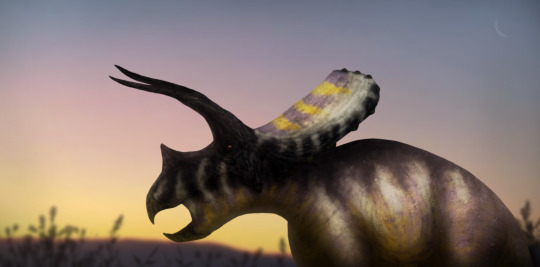
Quick drawing of Torosaurus inspired by the nonbinary flag for Pride Month
#paleoart#my art#torosaurus#ceratopsian#ornithischia#dinosaur#herbivore#cretaceous#north america#chasmosaur#marginocephalia#prehistoric#extinct#animal#sciart#nature#pride#nonbinary#non-binary
41 notes
·
View notes
Text
Pachycephalosaurus

11 notes
·
View notes
Text
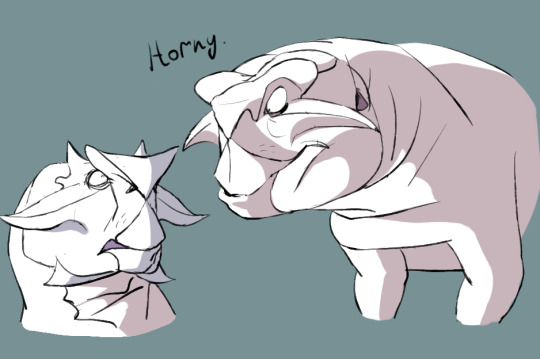
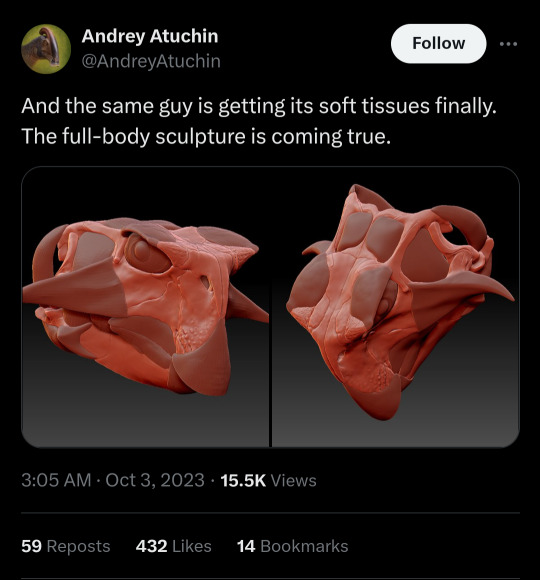
Fun fact: all dinosaurs have eyebrows!
In Saurischia, it was just soft tissue called supraorbital ridge, attached from prefrontal/lacrimal bone to postorbital. But in basal Ornithischia it were additionally supported by a dermal (it's likely osteoderm) palpebral/adlacrimal bone, and in derived herbivores brow arches ossified in tough supraorbitals. Some reptilians & birds still have this lil bony!
I think in Saurichia it may also get ossified, or osteoderm "horns" took its place, but I didn't find paper about

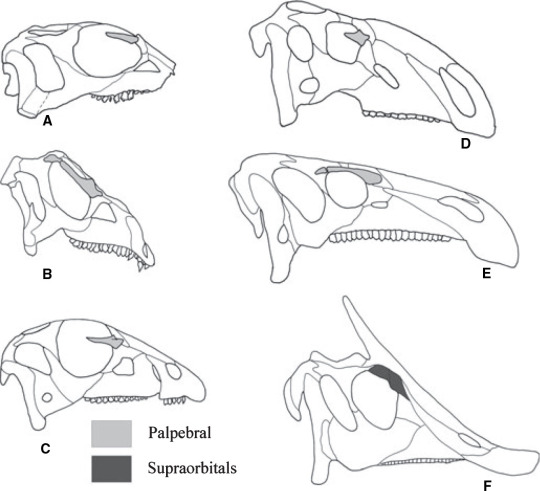
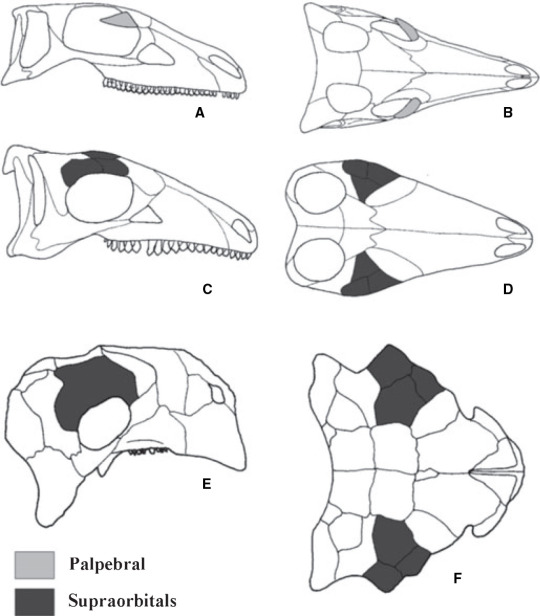
Here's article about this, I read only main points. I advise who lazy read under Figures (diagrams) and Discussion chapter:

non-shadow
#psittacosaurus#sibiricus#dinosaur#ceratopsian#mesozoic#paleoart#paleontology#prehistoric#scientifically accurate yo#cartoony n gloomy brows#marginocephalia#reference
69 notes
·
View notes
Link
*deep breath* Yeah this is inaccurate let me list all of them out.
1. This thing is implied to be a ceratopsian which all of them are herbivores, which they should have eyes like that of a goat’s eyes horizontally slit than vertically slit like what you’d see on a predator like a cat or a snake
2. Its feet should look more dinosaur-like rather than elephantine.
3. The front limbs should be sprawling but I’ll excuse it because it is hard to give a 2D drawing a sprawling position unless it’s from the front.
4. The legs are too short but the body and tail proportions are correct for a ceratopsian ironically.
5. Too many spikes on it’s tail I’ll accept it if those are more rather made out of keratin which I am surprised that none of the carnivores in it’s local environment haven’t gone extinct yet...
I hope this taught yall something and btw if I remember correctly this is my first post
#ceratopsian#ornithischia#dinosaur#dinosauria#inaccuracies#kosmoceratops#awesomebro#scientific inaccuracies#ceratopsidae?#marginocephalia#leptoceratopsidae?
1 note
·
View note
Text


Believe it or not, I also draw on occasion in addition to writing. Took my crack at the old tablet to draw some characters.
To the right are old concepts for Ralphanzo and Bertram. The left is the most accurate drawing of Turo to date.
Ralphanzo and Bertram went through some overhauls in their designs, such as the fact that neither of them wear clothes and some anatomical changes on the former.
It was a tough decision, but the prospect of "who was making clothes for dinosaurs?" was a bit too strong to ignore, so they were both rendered fully nude.
Ralphanzo had his crest shortened in the story since he's technically a child, was given hooves instead of fingers, and was changed from Parasaurolophus to Charonosaurus. He was a;so originally called "Rolfonzo", but this was also changed. His design is a tribute to the Parasaurolophus character Rolf from Dinosaur Adventure 3D but made more distinct. The name combined with the color palette wasn't legally distinct™ enough so the changes listed were made to be less derivative.
Bertram borrows his namesake from Bertram out of Scott Ciencin's Dinoverse books. He was also initially an Ankylosaurus, but this was changed to be Euoplocephalus in the story to differentiate himself. The club tail on the end is more accurate to the species fossil in the story as well.
#art#creator's art#DPA#dinosaur planet adventures#turo#ralphanzo#bertram#euoplocephalus#charonosaurus#zuniceratops#ceratopsian#thyreophora#hadrosaur#marginocephalia#dinosaurs
1 note
·
View note
Text
If there's one small things I'd learn about watching Jurassic World Movies/Series, is that they like introducing new dinosaurs or hybrids on their next movie/season series
I'd would like to see Majunga and Guanlongs on Chaos Theory, What about you?
#jurassic world chaos theory#jurassic world camp cretaceous#camp cretaceous#chaos theory#jwcc#jwct#jurassic park#jurassic series#Jurassic World#sauropod#theropod#ceratopsian#ornithopods#pterosaur#Marginocepalia#thyreophora
23 notes
·
View notes
Text

Strange Symmetries #17: Spiky Surprise
Styracosaurus albertensis was a ceratopsid dinosaur living during the late Cretaceous about 75 million years ago, in what is now Alberta, Canada. Around 5m long (~16'), it was one of the most elaborately ornamented horned dinosaurs, with a long nose horn and multiple elongated spikes on its frill.
There was actually quite a lot of variation in the frills of Styracosaurus, with varying numbers of long spikes and extra hook-like projections present on some individuals. But one recently-discovered specimen nicknamed "Hannah" is especially surprising – it had a noticeable amount of asymmetry in its skull. The left and right sides show different numbers and arrangements of spikes, so much so that if the two halves had been discovered separately they might have been identified as belonging to two completely different species.
Frill arrangements are often used to define different ceratopsids, so if this level of individual variation and asymmetry existed in other species, too, then we may need to reevaluate some of them.
———
NixIllustration.com | Tumblr | Twitter | Patreon
#science illustration#strange symmetries#paleontology#paleoart#palaeoblr#styracosaurus#centrosaurinae#ceratopsid#ceratopsia#marginocephalia#ornithischia#dinosaur#art
489 notes
·
View notes
Text

Dino figure of the day: Eofauna Triceratops
28 notes
·
View notes
Text
Sphaerotholus triregnum Woodruff et al., 2023 (new species)
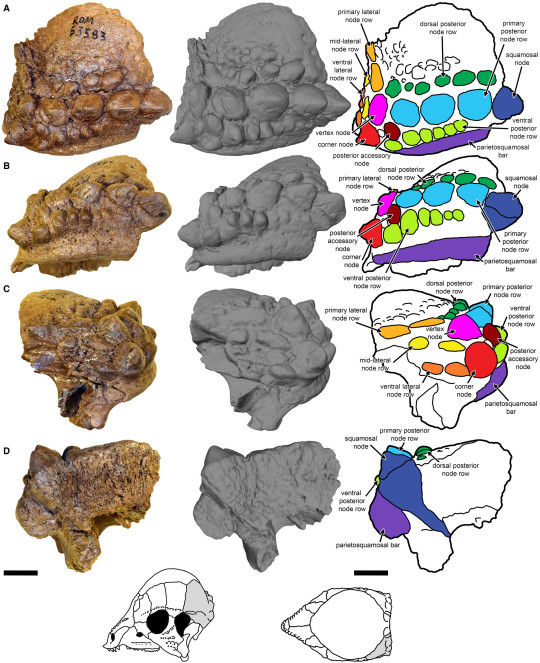
(Type squamosal [bone in the back of the skull] of Sphaerotholus triregnum [scale bars = 1 cm], from Woodruff et al., 2023)
Meaning of name: triregnum = triregnum [a domed, three-crowned ceremonial head piece worn by popes of the Catholic Church during the 14th Century]
Age: Late Cretaceous (Maastrichtian), between 66.9–67.2 million years ago
Where found: Hell Creek Formation, Montana, U.S.A.
How much is known: A nearly complete left squamosal (one of the bones in the back of the skull).
Notes: S. triregnum was a pachycephalosaur, a group of herbivorous dinosaurs famous for their thickened, domed skull. Three other species of Sphaerotholus had previously been named, S. goodwini from the Kirtland Formation of New Mexico; S. buchholtzae, also from the Hell Creek Formation, as well as the Frenchman Formation of Saskatchewan; and S. edmontonensis from the Horseshoe Canyon Formation of Alberta.
Despite being very incompletely known, S. triregnum can be distinguished from S. goodwini and S. buchholtzae in having three rows of bony bumps along the back of the squamosal, instead of only one. Squamosals have not been found for S. edmontonensis, but it had a distinctive character in that one of the bumps on the adjacent parietal bone would have also been partly formed by the squamosal (a feature found in S. buchholtzae as well), whereas the equivalent bump in S. triregnum originates from the squamosal alone.
Although some pachycephalosaurs (including S. buchholtzae) appear to have undergone dramatic changes in skull shape during growth, the arrangement of the numerous small bumps in the back of their heads seems to have remained fairly stable throughout their lifetimes, and is thus considered a reliable feature for identifying distinct species. Along with the also newly-named S. lyonsi from the Dinosaur Park Formation of Alberta, S. triregnum indicates that small pachycephalosaurs were likely more diverse than previously appreciated, even in well-studied Late Cretaceous fossil sites of North America.
Reference: Woodruff, D.C., R.K. Schott, and D.C. Evans. 2023. Two new species of small-bodied pachycephalosaurine (Dinosauria, Marginocephalia) from the uppermost Cretaceous of North America suggest hidden diversity in well-sampled formations. Papers in Palaeontology 9: e1535. doi: 10.1002/spp2.1535
#Palaeoblr#Dinosaurs#Sphaerotholus triregnum#Late Cretaceous#North America#Pachycephalosauria#2023#Extinct
44 notes
·
View notes
Text
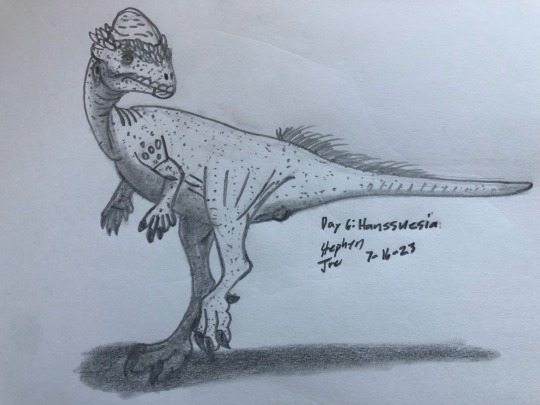
Day 6: Hanssuesia
A Pachycephalosaurid is synonymously known as Stegoceras (as of 2023 publication by three authors) of Judith River Formation.
#my art#dinosaur#paleoart#dinosaurs#myart#dinosauria#my drawings#ornithischia#marginocephalia#pachycephalosauria#pachycephalosauridae#hanssuesia#stegoceras#Judith River July#artists on tumblr#sketch pad
8 notes
·
View notes
Text
Two new species of small-bodied pachycephalosaurine (Dinosauria, Marginocephalia) from the uppermost Cretaceous of North America suggest hidden diversity in well-sampled formations
Published 16th November 2023
Two new small-bodied pachycephalosaurines, Sphaerotholus lyonsi and Sphaerotholus triregnum, are discovered: one from the Dinosaur Park Formation in
Alberta and the other from the Hell Creek Formation in Montana, both represented by an isolated squamosal.

Holotype left squamosal of Sphaerotholus triregnum

Holotype left squamosal of Sphaerotholus triregnum
Source:
23 notes
·
View notes